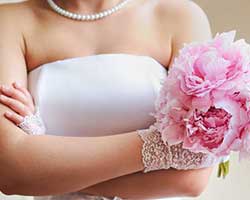The New York Institute of Art and Design offers one of the world's top online wedding planning courses, and because we do, we often offer free tips for wedding planners. Enjoy!
At the New York Institute of Art and Design, we know how to train wedding planners. We created our course using many top planners, and while they're careful to say that the planner is not automatically responsible for helping the bride select her wedding dress, very often the planner is asked for advice or taken along on the shopping trips. It's important to grasp the basics, and here are five things each planner should know.
- A wedding gown should ultimately fit into the overall theme and feel of the wedding. Weddings can be formal, semi-formal, or informal. Formal weddings call for rich fabrics such as satin (winter) or silk chiffon (summer), a full skirt, and a longer train. The bride usually covers her arms with long sleeves or long gloves and wears a headpiece with a veil. Semi-formal weddings have floor-length gowns or trains that just sweep the floor and vils that fall just below the shoulder or to the fingertips. Informal weddings offer floor or ballerina length dresses, a short chemise or even a dressy suit, and if there's a long gown, the bride's accessories should be streamlined to compliment the informal theme.
- Fashion is a personal thing. Observe your client's taste in everyday clothes and how they might indicate the type of gown that will appeal to her. Don't try steering her towards a dress that you like if it's not something she finds attractive. If it's a dress she hates, she won't listen to you telling her how beautiful she looks in it!
- Comfort is a key consideration for any dress. It will be worn for many hours and should resist wrinkling, snagging, or tearing. Depending on the time of year, it should be warm enough or cool enough for the bride to wear while she gets in and out of cars and limos, climbs stairs, dines, and dances.
- It's preferable to order a dress that's too big than too small. Bigger dresses can be taken in, but it's much harder to enlarge one. Try to discourage your client from ordering a smaller dress as a way to motivate her to lose weight. This causes unnecessary stress and makes the bride feel even worse if it doesn't work.
- Help your bride be on the lookout for quality in her wedding gown. Seams should be smooth with the fabric evenly matched. Stitches should be tight and uniform. You shouldn't see needle marks or hanging threads. Check the fabric—it should be topstitched or wrapped with seam binding. All linings should be heavy enough to conceal mid-layers, inner seams, boning, and undergarments. At the same time, it should be light enough to protect the integrity of the top layer. Lining interfacings should never be fused to the outer layer. (Our wedding planning course goes even further, covering the hallmarks of good quality with hems, zippers, buttons, loops, hooks, beads, lace, and corseting, too!)
Want to become a wedding planner? Enroll in NYIAD's wedding planning certification course. Request a free course catalog today.







